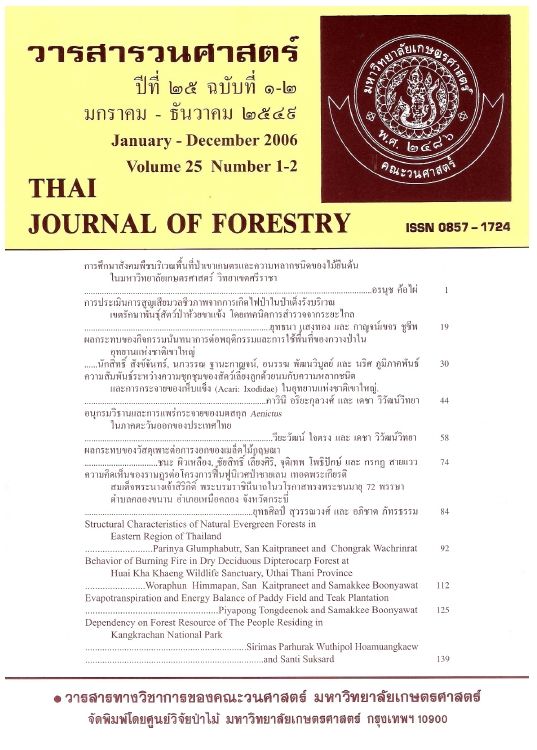EVAPOTRANSPIRATION AND ENERGY BALANCE OF PADDY FIELD AND TEAK PLANTATION
Main Article Content
บทคัดย่อ
The objectives of this study are to compare the evapotranspiration (ETa) and energy balance of paddy field and teak plantation and to develop regression models using simple climatic factors for estimation of evapotranspiration in paddy field and teak plantation. The automatic weather station (AWS) data observed at paddy field and teak plantation in Sukhothai and Lampang provinces collected between January 2002 – September 2004 were applied in this study. The results shown that the daily average solar radiation (Rs) in paddy field was 19.3 MJ m-2 day-1 with Rn of 13.2 MJ m-2 day-1 (70.4 % of Rs). The Rn was used for latent heat (LE), sensible heat (H), and storage in soil and water (Gs and Gw) with the average value of 9.5, 3.0, 0.4 and 0.2 MJ m-2 day-1 or 72.3, 2.9, 3.1 and 1.7% of Rn respectively. In teak plantation, the daily average Rs was estimated at 19.0 MJ m-2 day-1 ,. with an avergae daily Rn of 14.8 MJ m-2 day-1 or 78.2% of Rs. The Rn was used for LE, H and Gs about 71.6, 23.0 and 5.4% of Rn respectively. The average daily ETa of the whole peroid study in paddy field was 4.1 mm. while the average daily ETa of teak plantation was 3.9 mm. Regarding estimation of ETa based on general climatic factors using regression model, the most suitable model for paddy field was by found the highest correlation equation in December with r2 = 0.86, while in teak plantation the highest correlation with r2 = 0.84 was found in November. It can be said that the relationship between ETa and micrometeorological data was not applicable for almost all monthly periods. Only some month showed the significant relationship. It is thus recommended that there should be no more use the meteorological data to develop model for prediction ETa.
Downloads
Article Details

อนุญาตภายใต้เงื่อนไข Creative Commons Attribution-NonCommercial-NoDerivatives 4.0 International License.
ข้าพเจ้าและผู้เขียนร่วม (ถ้ามี) ขอรับรองว่า ต้นฉบับที่เสนอมานี้ยังไม่เคยได้รับการตีพิมพ์และไม่ได้อยู่ในระหว่างกระบวนการพิจารณาตีพิมพ์ลงในวารสารหรือสิ่งตีพิมพ์อื่นใด ข้าพเจ้าและผู้เขียนร่วม (ถ้ามี) ยอมรับหลักเกณฑ์และเงื่อนไขการพิจารณาต้นฉบับ ทั้งยินยอมให้กองบรรณาธิการมีสิทธิ์พิจารณาและตรวจแก้ต้นฉบับได้ตามที่เห็นสมควร พร้อมนี้ขอมอบลิขสิทธิ์ผลงานที่ได้รับการตีพิมพ์ให้แก่วารสารวนศาสตร์ คณะวนศาสตร์ มหาวิทยาลัยเกษตรศาสตร์ กรณีมีการฟ้องร้องเรื่องการละเมิดลิขสิทธิ์เกี่ยวกับภาพ กราฟ ข้อความส่วนใดส่วนหนึ่ง หรือ ข้อคิดเห็นที่ปรากฏในผลงาน ให้เป็นความรับผิดชอบของข้าพเจ้าและผู้เขียนร่วม (ถ้ามี) แต่เพียงฝ่ายเดียว และหากข้าพเจ้าและผู้เขียนร่วม (ถ้ามี) ประสงค์ถอนบทความในระหว่างกระบวนการพิจารณาของทางวารสาร ข้าพเจ้าและผู้เขียนร่วม (ถ้ามี) ยินดีรับผิดชอบค่าใช้จ่ายทั้งหมดที่เกิดขึ้นในกระบวนการพิจารณาบทความนั้น”


